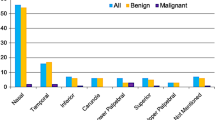Abstract
Purpose
We intended to review the clinical features and histological findings of eyelid lesions in Sri Lanka.
Methods
We conducted a descriptive cross-sectional study to analyse clinicopathological characteristics of eyelid lesions from 2013 to 2017 in the National Eye Hospital of Sri Lanka.
Results
The age of patients ranged from 3 months to 83 years (mean = 46 ± 21 years). The male-to-female ratio in the sample was 1:1.3. Among 654 histologically confirmed eyelid lesions, the majority (n = 407/654, 62%) were neoplastic lesions including 322 benign, 11 premalignant and 74 malignant neoplasms. The commonest benign tumour was seborrheic keratosis (n = 98), and the commonest non-neoplastic lesion was pyogenic granuloma (n = 64). Seventy-four patients had malignant neoplasia including 24 sebaceous carcinoma, 18 basal cell carcinoma, and 14 squamous cell carcinoma. The most common site of malignant lesions was the upper eyelid. The mean age of patients with malignant eyelid lesions was 64 ± 13 years.
Conclusions
Neoplastic lesions outnumbered nonneoplastic lesions, while benign neoplasia was more common than malignant neoplasia. In contrast to the western reports, the commonest malignant neoplasm was sebaceous carcinoma.

Similar content being viewed by others
References
Pe’er J (2016) Pathology of eyelid tumors. Indian J Ophthalmol 64(3):177
Reifler DM et al (1987) Tricholemmoma of the eyelid. Ophthalmology 94(10):1272–1275
Deprez M, Uffer S (2009) Clinicopathological features of eyelid skin tumors a retrospective study of 5504 cases and review of literature. Am J Dermatopathol 31(3):256–262
Fazil K et al (2020) Evaluation of Demographic Features of Eyelid Lesions. Beyoglu Eye J 5(2):114–117
Gali HE et al (2020) Retrospective analysis of incidence rates of benign and malignant eyelid lesions at a San Francisco Bay area tertiary hospital. Invest Ophthalmol Vis Sci 61(7):4673–4673
Milman T, McCormick SA (2013) The molecular genetics of eyelid tumors: recent advances and future directions. Graefes Arch Clin Exp Ophthalmol 251(2):419–433
Silverman N, Shinder R (2017) What’s new in eyelid tumors. Asia Pac J Ophthalmol 6(2):143–152
Huang Y-Y et al (2015) Comparison of the clinical characteristics and outcome of benign and malignant eyelid tumors an analysis of 4521 eyelid tumors in a tertiary medical center. BioMed Res Int. https://doi.org/10.1155/2015/453091
Lee S-B et al (1999) Incidence of eyelid cancers in Singapore from 1968 to 1995. Br J Ophthalmol 83(5):595–597
Mohan BP, Letha V (2017) Profile of eye lid lesions over a decade: a histopathological study from a tertiary care center in South India. Int J Adv Med 4(5):1406–1411
Abdi U et al (1996) Tumours of eyelid: a clinicopathologic study. J Indian Med Assoc 94(11):405–409
Bagheri A et al (2013) Eyelid masses: a 10-year survey from a tertiary eye hospital in Tehran. Middle East Afr J Ophthalmol 20(3):187
Xu XL et al (2008) Eyelid neoplasms in the Beijing Tongren Eye Centre between 1997 and 2006. Ophthalmic Surg Lasers Imaging Retina 39(5):367–372
Baek SH, Chi MJ (2006) Clinical analysis of benign eyelid and conjunctival tumors. Ophthalmologica 220(1):43–51
Cook BE Jr, Bartley GB (1999) Epidemiologic characteristics and clinical course of patients with malignant eyelid tumors in an incidence cohort in Olmsted County. Minnesota. Ophthalmol 106(4):746–750
Lober CW, Fenske NA (1991) Basal cell, squamous cell, and sebaceous gland carcinomas of the periorbital region. J Am Acad Dermatol 25(4):685–690
Gallagher RP et al (1995) Sunlight exposure, pigmentary factors, and risk of nonmelanocytic skin cancer: I. Basal cell carcinoma Arch Dermatol 131(2):157–163
Paul S, Vo DT, Silkiss RZ (2011) Malignant and benign eyelid lesions in San Francisco: study of a diverse urban population. Am J Clin Med 8(1):40–46
Wang J et al (2003) Malignant eyelid tumours in Taiwan. Eye 17(2):216–220
Özdal PÇ et al (2004) Accuracy of the clinical diagnosis of chalazion. Eye 18(2):135–138
Lin H-Y et al (2006) Incidence of eyelid cancers in Taiwan: a 21-year review. Ophthalmology 113(11):2101–2107
Acknowledgements
We would like to thank Dr. K.S Liyanage, Dr. M.Y.K Wilfred, Dr. A.S.B de Silva, Dr. I.L.M Riffaz and Dr. N.L.S.N Fernando, the Directors of the National Eye Hospital, for administrative support. The authors also thank the laboratory staff of the National Eye Hospital, Mrs. Ruvini Padmasiri, Mr. Saranath Cooray and Mr. Mahesh, for the technical support.
Author information
Authors and Affiliations
Contributions
DP, MM and YM contributed to the study conception and design. Material preparation, data collection and analysis were performed by MP, DK and DP. The first draft of the manuscript was written by YM and all authors commented on previous versions of the manuscript. All authors read and approved the final manuscript.
Corresponding author
Ethics declarations
Conflict of interest
The authors declare no competing interests.
Ethics approval
This study was performed in line with the principles of the Declaration of Helsinki. Approval was granted by the Ethics Review Committee of the National Eye Hospital Sri Lanka.
Consent to participate
Informed consent was obtained from all individual participants included in the study.
Additional information
Publisher's Note
Springer Nature remains neutral with regard to jurisdictional claims in published maps and institutional affiliations.
Supplementary Information
Below is the link to the electronic supplementary material.
Rights and permissions
Springer Nature or its licensor (e.g. a society or other partner) holds exclusive rights to this article under a publishing agreement with the author(s) or other rightsholder(s); author self-archiving of the accepted manuscript version of this article is solely governed by the terms of such publishing agreement and applicable law.
About this article
Cite this article
Nanayakkara, D.P.S., Dissanayake, M.M., Gunaratne, M.P. et al. Clinicopathological analysis of eyelid lesions in Sri Lanka. Int Ophthalmol 43, 2513–2519 (2023). https://doi.org/10.1007/s10792-023-02651-z
Received:
Accepted:
Published:
Issue Date:
DOI: https://doi.org/10.1007/s10792-023-02651-z




